Standard [CURRENT]
ASTM E 603:2025
Standard Guide for Room Fire Experiments
- Publication date
- 2025
- Original language
- English
- Pages
- 20
- Publication date
- 2025
- Original language
- English
- Pages
- 20
- DOI
- https://dx.doi.org/10.1520/E0603-25
Product information on this site:
Quick delivery via download or delivery service
Buy securely with a credit card or pay upon receipt of invoice
All transactions are encrypted
Short description
1.1 This guide addresses means of conducting full-scale fire experiments that evaluate the fire-test-response characteristics of materials, products, or assemblies under actual fire conditions. 1.2 It is intended as a guide for the design of the experiment and for the use and interpretation of its results. The guide is also useful for establishing laboratory conditions that simulate a given set of fire conditions to the greatest extent possible. 1.3 This guide allows users to obtain fire-test-response characteristics of materials, products, or assemblies, which are useful data for describing or appraising their fire performance under actual fire conditions. 1.3.1 The results of experiments conducted in accordance with this guide are also useful elements for making regulatory decisions regarding fire safety requirements. The use for regulatory purposes of data obtained from experiments conducted using this guide requires that certain conditions and criteria be specified by the regulating authority. 1.4 The rationale for conducting room fire experiments in accordance with this guide is shown in 1.5 - 1.8 . 1.5 Room fire experiments are a means of generating input data for computer fire models and for providing output data with which to compare modeling results. 1.6 One of the major reasons for conducting room fire experiments is as an experimental means of assessing the potential fire hazard associated with the use of a material or product in a particular application. This should be borne in mind when designing nonstandard experiments. 1.7 A rationale for conducting room fire experiments is the case when smaller-scale fire tests inadequately represent end-use applications. 1.8 A further rationale for conducting room fire experiments is to verify the results obtained with smaller scale tests, to understand the scaling parameters for such tests. 1.9 Room fire tests can be placed into four main categories: reconstruction, simulation, research, and standardization. 1.10 This standard is used to measure and describe the response of materials, products, or assemblies to heat and flame under controlled conditions, but does not by itself incorporate all factors required for fire hazard or fire risk assessment of the materials, products, or assemblies under actual fire conditions 1.11 This standard does not purport to address all of the safety concerns, if any, associated with its use. It is the responsibility of the user of this standard to establish appropriate safety, health, and environmental practices and determine the applicability of regulatory limitations prior to use. 1.12 This international standard was developed in accordance with internationally recognized principles on standardization established in the Decision on Principles for the Development of International Standards, Guides and Recommendations issued by the World Trade Organization Technical Barriers to Trade (TBT) Committee.
ICS
13.220.50
DOI
https://dx.doi.org/10.1520/E0603-25
Also available in
Loading recommended items...
Loading recommended items...
Loading recommended items...
Loading recommended items...

